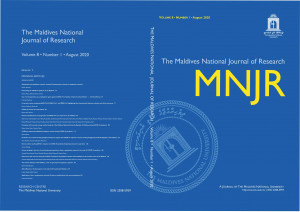Sensory properties of white bread enriched with lemon juice, corn flour and baking soda
DOI:
https://doi.org/10.62338/1bnwd591Keywords:
anticaking agents, corn flour, lemon soda bread, sensory evaluation, MaldivesAbstract
Bread is one of the most common food staples highly consumed by Maldivians. Food additives such as anticaking agents (baking soda), thickener (corn flour) and chelator (lemon juice) were used to enrich bread and introduced to the Maldivian market in order to determine how these anti-caking agents changed the overall acceptability including taste, aroma, appearance, texture and colour by consumers as a healthier and tastier alternative for normal white bread. The aim of the study was to determine how the addition of corn flour, lemon juice and baking soda to bread changed the overall acceptability including taste, aroma, appearance, texture and colour by consumers. Enriched bread and white bread (control) samples were sliced into equally sized pieces and served separately for each participant. The sensory evaluation of the bread samples was studied using a 9-point Hedonic scale with 30 random participants to determine the overall acceptability and the mean score for taste, appearance, texture and color. Using Microsoft Excel and SPSS software, the data was analyzed and graphs were generated. The enriched bread had overall acceptability of 6.97±0.89 and the mean values of taste (6.2±1.19), appearance (7.13±0.70), texture (7.07±0.98) and colour (7.2±0.85). The aroma of the lemon soda bread was found less favorable (5.47±1.17) compared top the enriched bread. The overall acceptability of enriched bread was rated ‘like moderately’ by 43.3% participants although 70% of the participants rated ‘like very much’ for normal white bread. The new formulation could be improved to increase the consumer likeness to the taste, particularly variating the formulation of lemon and corn flour.
References
Barber, B., Ortola, C., Barber, S., & Fernandez, F. (1992). Storage of packaged white bread. Zeitschrift for Lebensmittel-Untersuchung Und -Forschung, 194(5),442–449. https://doi.org/10.1007/bf01197726
Callejo, M. J. (2011). Present situation on the descriptive sensory analysis of bread. Journal of Sensory Studies, 26(4), 255–268. https://doi.org/10.1111/j.1745-459X.2011.00341.x
Cervenka, L., Brožková, I., & Vytrasová, J. (2006). Effects of the principal ingredients of biscuits upon water activity. Journal of Food and Nutrition Research, 45(1), 39–43. https://www.researchgate.net/publication/299055076_Effects_of_the_principal_ingredients_of_biscuits_upon_water_activity#:~:text=Linear regression analysis revealed that,moisture and total protein contents.&text=Using this formula it could,influenced by mo
Chang, R., Li, C., & Shiau, S. (2015). Physico-chemical and Sensory Properties of Bread Enriched with Lemon Pomace Fiber. Czech Journal of Food Sciences, 33(2), 180–185. https://doi.org/10.17221/496/2014-CJFS
Freitas, D., Boué, F., Benallaoua, M., Airinei, G., & Benamouzig, R. (2020). Lemon juice, but not tea, reduces the glycemic response to bread in healthy volunteers: a randomized crossover trial. European Journal of Nutrition. https://doi.org/10.1007/s00394-020-02228-x
Gioia, L. C., Ganancio, J. R., & Steel, C. J. (2017). Food Additives and Processing Aids used in Breadmaking. In Food Additives. https://doi.
org/10.5772/intechopen.70087
Hsieh, C. Y., Hsieh, S. L., Ciou, J. Y., Huang, Y. W., Leang, J. Y., Chen, M. H., & Hou, C. Y. (2021). Lemon juice bioactivity in vitro increased with lactic acid fermentation. International Journal of Food Properties, 24(1), 28–40. https://doi.org/10.1080/10942912.2020.1861008
Khan, M. U., Majeed, M., Tayyab, M., Shariati, M. A., & Rashidzadeh, S. (2016). Chemical and Nutritional Properties of Some Commercial Available Corn and Wheat Products. Journal of Microbiology, Biotechnology and Food Sciences, 6(2), 863–866. https://doi.org/10.15414/jmbfs.2016.6.2.863-866
Larsson, A. (2016). Evaluation of Natural Anti- caking Agents in Spices and Spice Blends [Chalmers University of Technology]. https://publications.lib.chalmers.se/records/fulltext/239315/239315.pdf
Luiz, R. O., & Vanin, F. M. (2021). Effect of straight dough X pre-fermented dough method on composite wheat breads characteristics. Food Science and Technology, 2061, 1–7. https://doi.org/10.1590/fst.64420
Nikolic, N., Mitrovic, J., Karabegovic, I., Savic, S., Petrovic, S., Lazic, M., & Stojanovic, G. (2019). A comparison between wheat and different kinds of corn flour based on minerals, free phenolic acid composition and antioxidant activity. Quality Assurance and Safaety of Crops & Foods, 11(4), 341–349. https://doi.org/10.3920/QAS2018.1411
Penniston, K. L., Nakada, S. Y., Holmes, R. P., & Assimos, D. G. (2008). Quantitative assessment of citric acid in lemon juice, lime juice, and
commercially-available fruit juice products. Journal of Endourology, 22(3), 567–570. https://doi.org/10.1089/end.2007.0304
Quita, S. M. (2016). Evaluation of lemon fruit extract as an antioxidant agent against histopathological changes induced by cyclophosphamide in the testes of albino mice. Electronic Physician (ISSN:, 8(1), 1824–1831. https://doi.org/
http://dx.doi.org/10.19082/1824
Saha, D., & Bhattacharya, S. (2010). Hydrocolloids as thickening and gelling agents in food: A critical review. Journal of Food Science and Technology, 47(6), 587–597. https://doi.org/10.1007/s13197-010-0162-6
Sajdakowska, M., G˛ebski, J., Je˙zewska-Zychowicz, M., & Królak, M. (2021). Consumer Choices in the Bread Market: The Importance of Fiber in Consumer Decisions. Nutrients, 13(1), 132. https://doi.org/https://doi.org/10.3390/nu13010132
Scarton, M., Ganancio, J. R. C., de Avelar, M. H. M., Clerici, M. T. P. S., & Steel, C. J. (2021). Lime juice and enzymes in clean label pan bread: baking quality and preservative effect. Journal of Food Science and Technology, 58(5), 1819–1828. https://doi.org/10.1007/s13197-020-04693-y
Singh-ackbarali, D., & Maharaj, R. (2014). Sensory Evaluation as a Tool in Determining Acceptability of Innovative Products Developed by
Undergraduate Students in Food Science and Technology at The University of Trinidad and Tobago. Journal of Curriculum and Teaching, 3(1), 10–27. https://doi.org/10.5430/jct.v3n1p10
Siyuan, S., Tong, L., & Liu, R. H. (2018). Corn phytochemicals and their health benefits. Food Science and Human Wellness, 7(3), 185–195. https://doi.org/10.1016/j.fshw.2018.09.003
Skendi, A., Papageorgiou, M., & Varzakas, T. (2021). High protein substitutes for gluten in gluten-free bread. Foods, 10(9), 1–16. https://doi.org/10.3390/foods10091997
Taghdir, M., Mazloomi, S. M., Honar, N., Sepandi, M., Ashourpour, M., & Salehi, M. (2017). Effect of soy flour on nutritional, physicochemical, and sensory characteristics of gluten-free bread. Food Science and Nutrition, 5(3), 439–445. https://doi.org/10.1002/fsn3.411
Teixeira, A. K. M., Silva, R. R., Lima, C. M. G., Pagnossa, J. P., Gonçalves, J. T. T., Barbosa, A. A., Oliveira, M. de C. M., & Santana, R. F. (2019). Whole grain bread preserved with lemon juice: a comparative study. Brazilian Journal of Development, 5(12), 33381–33391. https://doi.org/10.34117/bjdv5n12-38



